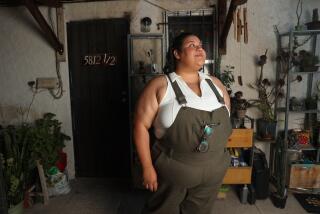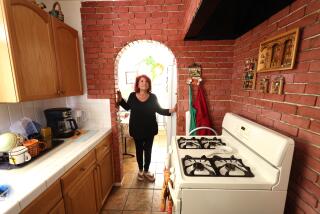Condo crazy, again
- Share via
Anne Do is used to sharing walls. She rented at Warner Center Apartments for three years while trying to buy a home. But after repeatedly losing bidding wars to equity-rich buyers, the 35-year-old commercial real estate attorney was losing hope of ever owning.
Then in October, the new owners of Do’s Woodland Hills complex offered tenants the right of first refusal to purchase the 1,279 rental units being renovated to for-sale condominiums. Do saw her opportunity and bought an 1,100-square-foot, two-bedroom, two-bathroom condo conversion in the renamed Metropolitan at Warner Center for $390,000.
Revisiting a trend first popularized in the 1980s, developers are cashing in on demand from entry-level buyers, investors and boomers by turning apartments into for-sale condominiums. And although conversions deplete rental stock, analysts and brokers say with strong home-price appreciation and buyers waiting in the wings, the profitable apartment-conversion movement shows no signs of slowing.
For apartment complex owners, “income property averages $80,000 to $100,000 per unit in some areas,” said Corrine Cote, a sales associate with Re/Max College Park in Los Alamitos, who has sold conversions since the early 1990s. “But if that property has been paying for itself for several years, and the market is hot, why not do a condo conversion and make three times what you paid for each unit?”
The Southland conversion resurgence started in San Diego, according to Russ Valone, president for MarketPointe Realty Advisors. From 1996 to 2001, San Diego County developers sold fewer than 500 conversions a year. Then conversions increased from 731 in 2002 to 3,492 in 2004 -- a 378% rise -- and topped 1,306 for the first quarter of 2005, Valone said.
“The reason conversions have done so well in San Diego is because of the $185,000 price gap between a conversion unit and a new-construction condominium,” he said. “This is going to be a big trend.”
More Southland condo conversions are in the works. Roddel & Associates Inc., a Tustin-based sales and marketing firm, is selling 1,133 condo conversions in Corona, Temecula, Riverside and San Diego.
“It’s a craze right now,” said Tom Roddel, the firm’s president and owner. “It’s a win-win for the buyer and the converter.”
One of Do’s initial worries was whether her unit might be slow to appreciate. The demand for affordable housing, however, has helped Southland condos appreciate more quickly than detached homes in the last several years, regardless of whether they are conversions, said Robert Kleinhenz, deputy chief economist for the California Assn. of Realtors.
From March 2002 to March 2005, the median price of resale homes in Los Angeles County increased 77.6% compared with 89.5% for condos, reported La Jolla-based research firm DataQuick Information Systems. According to John Karevoll, chief analyst for DataQuick, the condo market has just kicked into gear later than detached housing, and the values are playing catch-up.
Many buyers are finding the price is right. Broker-associate Don Heller specializes in new and converted condo sales at Prudential California Realty in Brentwood, where twobedroom area condos sell for about $800,000 to $900,000 and conversions sell for $600,000 to $700,000.
In Corona, where the selling price for condos is in the $300,000-to-$500,000 range, Roddel said conversions range from $200,000 to $310,000.
Condos in the 29-acre Metropolitan complex, being developed by Carlsbad property management company Macbeth Apartment Systems and Calabasas-based Troxler Residential Ventures, are being sold in phases over a two-year period.
Do, who still lives in her rental, plans to move into her new condo in June. On top of her 100% financed, $2,000-a-month mortgage, she will pay homeowners’ association dues, which range from about $175 to $200 per month at the Metropolitan, and property taxes of about $400 per month.
“I’m hoping condo conversions will become a way of the future for single professionals looking for a more permanent sense of homeownership,” said Do, who walks to her job in the Warner Center business district.
Indeed, single households accounted for 44% of all condo buyers, according to a recent report by the California Assn. of Realtors.
“This is a good way for people to get a toehold to owning real estate in Southern California,” said Phil Sidenberg, director of sales and marketing for the Metropolitan, which targets first-time buyers in their late 20s and early 30s.
But conversions are not without critics.
Arlen Shire, a retired naval petty officer who lives on a fixed income, said conversions are displacing Southland renters, families with young children and fixed-income residents who can’t afford to buy.
For more than 20 years, the 67-year-old rented in the Southgate Village Apartments in the Otay Mesa area of San Diego. But with the 188-unit complex slated for a conversion pending city approval, Shire moved from his two-bedroom unit to another complex last May.
According to Karen Washam, a spokeswoman for Southgate developer Ralph Bwy, the converted units were offered to residents for $230,000 to $265,000 in December.
“Even with first-time buying programs, many of these conversions are way out of the financial ballpark for most renters in this area,” Shire said. “Some of these people are working two or three jobs just to pay their monthly rent.”
Renter Richard Helwig, who still lives in Shire’s former building, pays about $800 for one bedroom now. Hesaid another place to rent will cost about $1,000 or $1,200 a month.
State law mandates that developers give tenants a 90-day right to purchase and 90 days from the day they were notified or the term of their lease to vacate the premises. Regional protection for ousted renters varies by city. Someone renting a city of Los Angeles rent-controlled unit (any unit built before Oct. 1, 1978), for example, has 120 days to vacate.
Moreover, the Los Angeles Rent Stabilization Ordinance, which covers rental housing units within the city limits, requires converters to provide $3,200 in relocation assistance, or $8,000 if the tenant has minor children, a legal disability or is older than 62.
Converters eager to free up units before notice terms expire often entice renters with paid moving expenses and discounts that can be used toward the purchase price or closing costs.
Given the choice to move or buy, Jennifer Daoud, 31, purchased a 1,125-square-foot, two-bedroom unit at Triana at Corona Ranch for $304,000. “It’s totally refurbished and beautiful,” she said.
Longtime renter Shannon Wallace, 39, a divorced mother of two children, ages 7 and 13, bought a three-bedroom, two-bathroom conversion in the Metropolitan for $389,000.
Do, Daoud and Wallace declined a standard developer option that allows existing tenants to purchase their current unit “as-is” for a reduced price -- $10,000 less in Daoud’s case.
Even with incentives, however, Roddel estimated that only 5% of renters elect to buy.
“I think it’s because they have a renter mentality and are more nomadic,” he said.
Wallace’s 1,092-square-foot conversion features upgraded window treatments and light fixtures, granite countertops, Berber carpets, cherrywood floors and stainless-steel appliances including a dishwasher, a microwave, an oven and a stacked washer and dryer.
“I’ve had people tell me that it’s a lot to pay for an apartment, but then when they tour the unit and the complex and see what I am getting, they change their mind,” Wallace said. Proximity to good schools, shopping, freeway access and amenities such as gardens, pools, spas, tennis and racquetball courts and state-of-the-art fitness centers complete the package.
“If I bought somewhere else, I would have to pay extra for a gym membership,” she said. “Here, I can walk to the gym or the pool from my house, and I don’t have to worry about maintenance.”
The only downside, said Wallace, who parks underground, is not having an individual garage.
In selecting her unit, she considered access, privacy, views to and from neighboring units, and noise from the pool and the street.
Wallace, who plans to move to her new home in October, selected a third-floor unit facing an open courtyard and said she likes the view.
“I am hoping I can use this as a stepping stone to upgrade to another home,” she said.
Michelle Hofmann can be reached at michelle [email protected].
More to Read
Inside the business of entertainment
The Wide Shot brings you news, analysis and insights on everything from streaming wars to production — and what it all means for the future.
You may occasionally receive promotional content from the Los Angeles Times.










